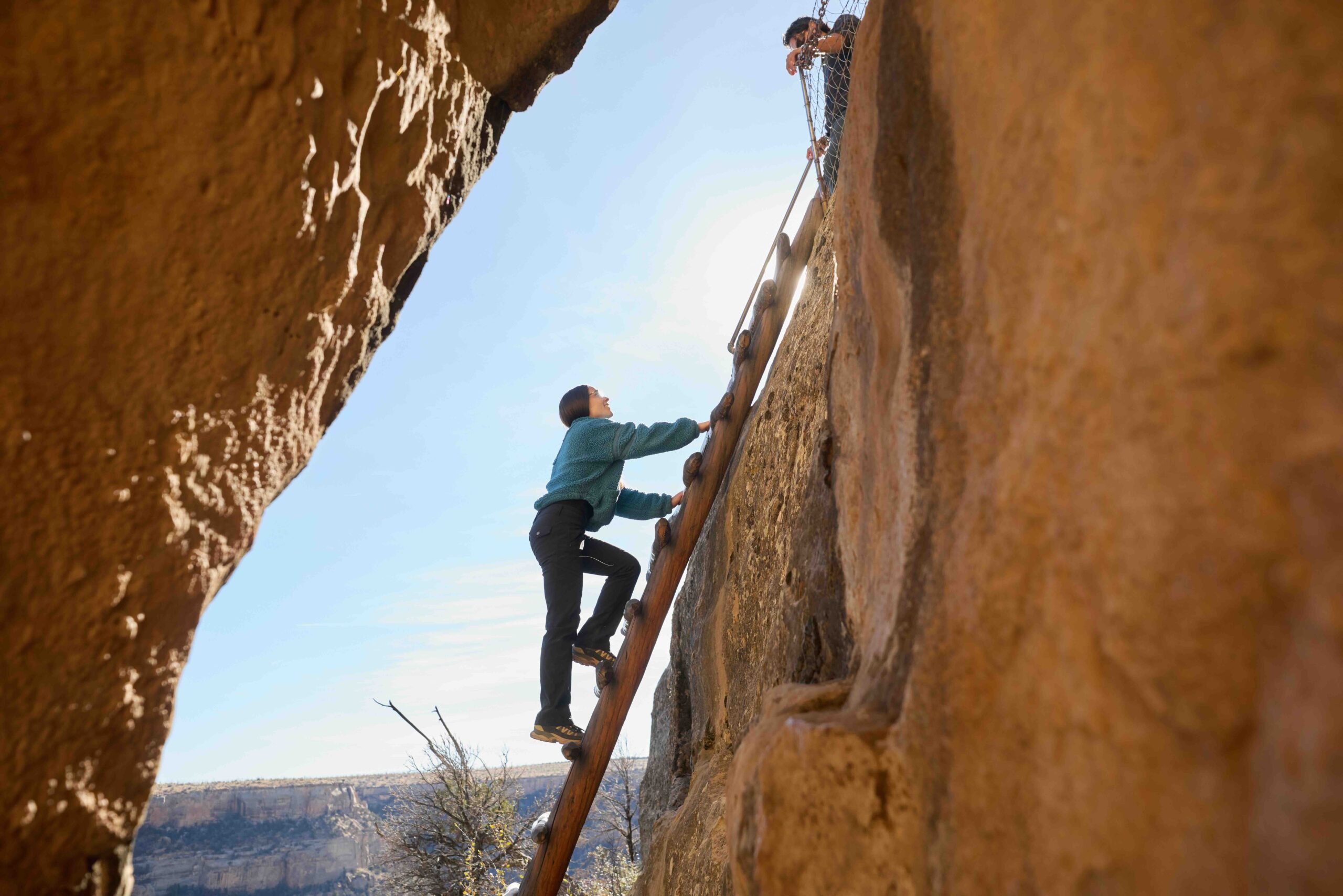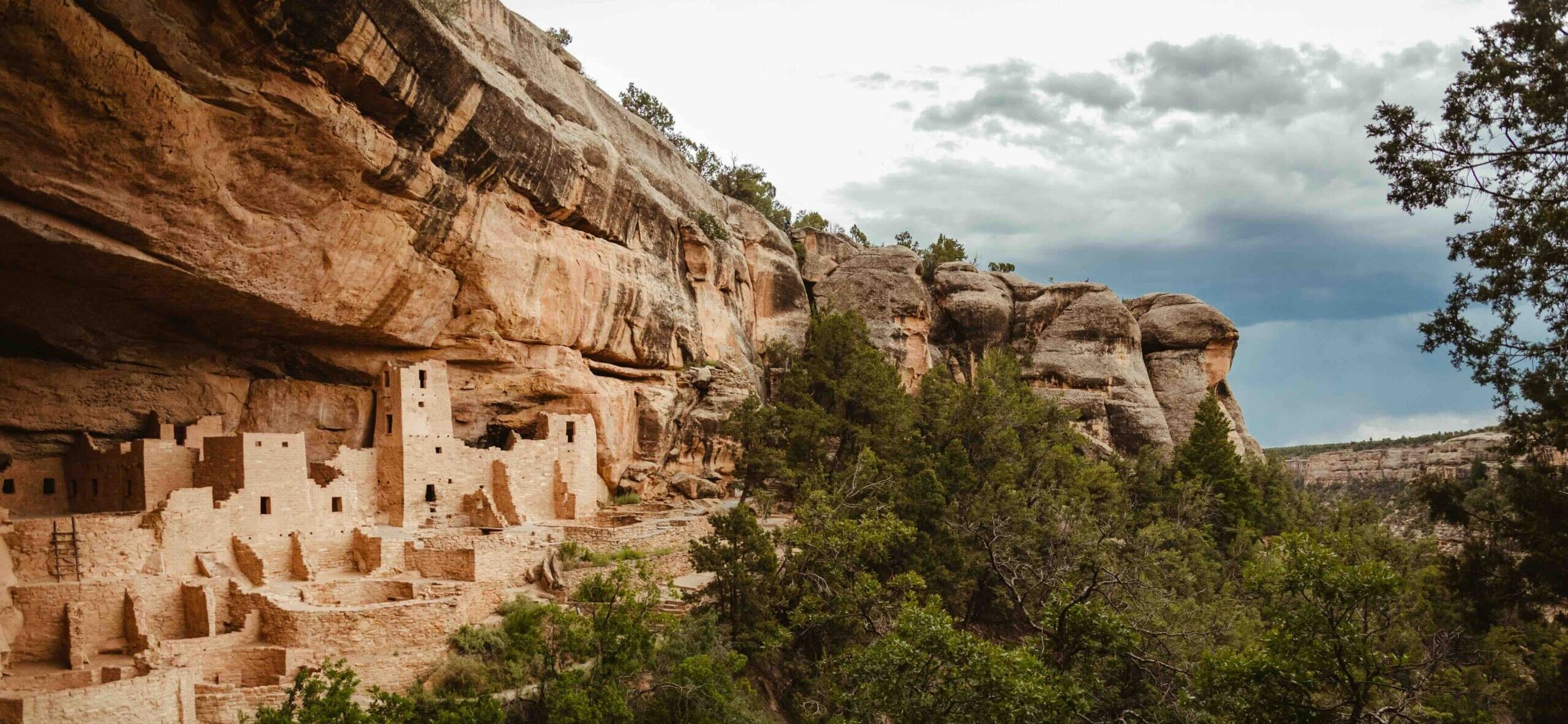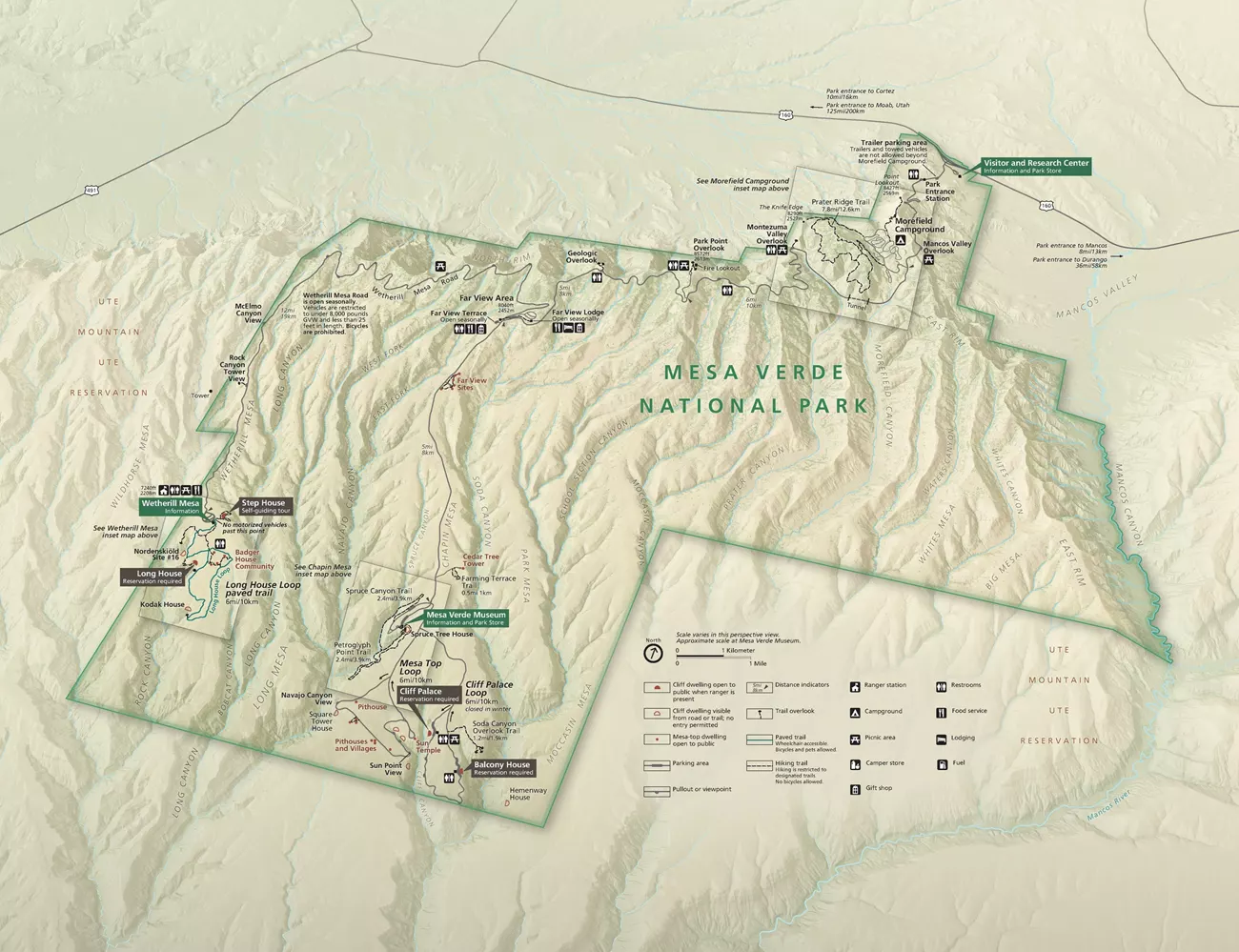Mesa Verde National Park
The park is open year round, but tours and some programs are only available seasonally. Check the park website for details when planning your visit.
Nestled in the heart of Southwest Colorado, Mesa Verde National Park is a UNESCO World Heritage Site known for its ancient cliff dwellings, archaeological treasures, and breathtaking high-desert landscapes. Home to the Ancestral Puebloans for more than 700 years, this park offers a rich mix of cultural history, outdoor adventure, and scenic beauty that captivates visitors year-round.
Whether you’re planning a day trip or a multi-day stay, Mesa Verde promises an unforgettable journey into the past.
Mesa Verde National Park History
Established in 1906, Mesa Verde National Park was the first U.S. national park created to preserve cultural heritage. It protects nearly 5,000 archaeological sites, including 600 cliff dwellings built by the Ancestral Puebloan people between 600 and 1300 CE.
While still farming the mesa tops, many Ancestral Puebloans lived in pueblos built beneath the overhanging cliffs. The structures ranged in size from one-room storage areas to villages of more than 150 rooms. They continued to reside in the alcoves—repairing, remodeling, and constructing new rooms—for nearly a century.
The sites left behind are some of the most notable and best-preserved in the United States. In 1978, Mesa Verde National Park was named a UNESCO World Heritage Site in recognition of its exceptional archaeological relevance. Mesa Verde National Park preserves a spectacular look into the ancient lives of America’s First Peoples.
From the iconic Cliff Palace to remote mesa-top pithouses, these sites offer a powerful glimpse into the daily life, spirituality, and innovation of an ancient civilization that once thrived in this rugged terrain.

Things To Do at Mesa Verde National Park
There are countless things to do in Mesa Verde National Park, from touring ancient dwellings to hiking scenic trails and enjoying stargazing in a certified International Dark Sky Park.
Top Activities in Mesa Verde National Park
-
Take a Ranger-Guided Tour of Balcony House, Cliff Palace, or Square Tower House to step inside the dwellings once home to the Ancestral Puebloans.
-
Hike the Petroglyph Point Trail, which features ancient rock carvings and panoramic canyon views.
-
Drive the Mesa Top Loop, a 6-mile scenic road with stops at excavated pithouses and panoramic overlooks.
-
Visit Mesa Verde in winter for a quiet, snowy experience with unique photography opportunities and fewer crowds.
-
Explore on a self-guided tour if ranger-led options are full—there are several easily accessible trails and overlooks throughout the park.
Mesa Verde National Park Tours
Mesa Verde National Park cliff dwelling tours offer a rare opportunity to step inside ancient homes built into the cliffs more than 700 years ago. These ranger-led experiences provide meaningful insight into the lives and legacy of the Ancestral Puebloan people—and are a highlight for many park visitors.
Access to Cliff Palace, Balcony House, and Square Tower House is available only through ranger-guided tours, which should be reserved in advance. On Wetherill Mesa, you can explore the Long House on a ranger-led tour or visit Step House at your own pace on a self-guided tour.
The 2025 tour season runs from May 4 through October 19, with Wetherill Mesa opening May 23, 2025.
Cliff Palace Tour
Mesa Verde’s most iconic site, Cliff Palace is the largest known cliff dwelling in North America. With over 150 rooms and 23 ceremonial kivas, it showcases the scale and sophistication of Ancestral Puebloan architecture. This 45-minute ranger-led tour includes a short 1/4-mile walk, uneven stone steps, and four ladders, with a total elevation change of 100 feet. It’s a memorable and accessible way to explore one of the park’s most impressive archaeological treasures.
Balcony House Tour
If you’re up for a bit of a thrill, Balcony House delivers. This one-hour tour is often described as Mesa Verde’s most adventurous, featuring a 32-foot ladder climb, a narrow tunnel crawl, and a steep exit up the cliff face via additional ladders and stone steps. The experience is physically demanding but unforgettable, offering a hands-on sense of what daily life and movement through these dwellings might have felt like centuries ago.
Square Tower House Tour
Located in the park’s backcountry, Square Tower House offers one of Mesa Verde’s most intimate and striking experiences. It’s home to the tallest standing structure in Mesa Verde and features extensive ancestral rock art that brings the story of this site to life. This 90-minute ranger-guided tour is limited to just 10 participants per day, making it an opportunity to explore a lesser-seen cliff dwelling in a more personal setting. The 1-mile roundtrip hike includes uneven terrain, switchbacks, narrow ledges, and two ladders—ideal for visitors seeking a more adventurous, off-the-beaten-path experience.
Backcountry tours run once daily starting May 4, 2025 and require advance reservations.
Wetherill Mesa Tours
**Open May 23, 2025**
Long House Tour
Found on the quieter, more remote Wetherill Mesa, Long House offers a spacious and open-air alternative to the more enclosed cliff dwellings. The 75-minute ranger-led tour includes a scenic 2.25-mile roundtrip hike, two ladders, and plenty of room to reflect and explore. You’ll wander through a large central plaza, observe natural springs still active today, and gain insight into how water shaped the lives and settlements of the Ancestral Puebloans. Reaching the trailhead requires a 0.75-mile walk from the Wetherill Mesa Kiosk, so be sure to arrive early.
Step House
Step House is ideal for visitors who want to explore at their own pace. This self-guided tour in Mesa Verde National Park takes visitors through a unique site where two eras of Puebloan life come together: a 600 CE pit house and a 1200 CE cliff dwelling, both nestled within the same sandstone alcove. The site is accessible via a short walk from the Wetherill Mesa parking area, and while no reservations are needed, rangers are often on hand to answer questions and provide context along the way.
Note: Wetherill Mesa is accessed by a 12-mile drive on a narrow road. Allow at least 1.5 hours from the park entrance. Large vehicles are not permitted.
Tour Tips for Mesa Verde National Park
Planning ahead will help you make the most of your Mesa Verde tour experience—especially since the park’s high elevation, rugged terrain, and seasonal tour availability can all impact your visit. Here are some tips to keep in mind:
-
Know your limits. Many tours involve climbing ladders, navigating uneven trails, and hiking at elevations between 7,000 and 7,500 feet. If you have heart, respiratory, or mobility issues, be sure to choose a tour that matches your comfort level.
-
Expect changing weather. Conditions can shift quickly, especially in spring and fall. Dress in layers and pack sun protection, rain gear, and plenty of water—at least 2 liters per person is recommended for longer tours.
-
Reserve early. Tours for Cliff Palace, Balcony House, Square Tower House, and Long House are popular and often sell out quickly. You can book tickets online at Recreation.gov up to two weeks in advance, starting at 8:00 a.m. Mountain Daylight Time.
-
Visit outside of peak hours. Early morning and late afternoon tours are often less crowded, and the lighting can be perfect for photos.
-
Check out evening programs. During summer, Morefield Campground hosts free ranger programs Thursday–Saturday evenings—no reservations required.
-
Explore on your own. For those who prefer to experience the park at their own pace, there are plenty of ways to connect with both its landscapes and history. Several hikes in Mesa Verde National Park lead to scenic viewpoints, mesa-top dwellings, and self-guided tours of archaeological sites like Step House on Wetherill Mesa.
Tour Tips for Mesa Verde National Park
Planning ahead will help you make the most of your Mesa Verde tour experience—especially since the park’s high elevation, rugged terrain, and seasonal tour availability can all impact your visit. Here are some tips to keep in mind:
-
Know your limits. Many tours involve climbing ladders, navigating uneven trails, and hiking at elevations between 7,000 and 7,500 feet. If you have heart, respiratory, or mobility issues, be sure to choose a tour that matches your comfort level.
-
Expect changing weather. Conditions can shift quickly, especially in spring and fall. Dress in layers and pack sun protection, rain gear, and plenty of water—at least 2 liters per person is recommended for longer tours.
-
Reserve early. Tours for Cliff Palace, Balcony House, Square Tower House, and Long House are popular and often sell out quickly. You can book tickets online at Recreation.gov up to two weeks in advance, starting at 8:00 a.m. Mountain Daylight Time.
-
Visit outside of peak hours. Early morning and late afternoon tours are often less crowded, and the lighting can be perfect for photos.
-
Check out evening programs. During summer, Morefield Campground hosts free ranger programs Thursday–Saturday evenings—no reservations required.
-
Explore on your own. For those who prefer to experience the park at their own pace, there are plenty of ways to connect with both its landscapes and history. Several hikes in Mesa Verde National Park lead to scenic viewpoints, mesa-top dwellings, and self-guided tours of archaeological sites like Step House on Wetherill Mesa.
Getting Around the Park
Navigating Mesa Verde is part of the adventure. The park’s unique layout takes you through high-elevation switchbacks and panoramic overlooks, connecting historic sites and scenic trails across the landscape.
We recommend starting your visit at the Mesa Verde Visitor and Research Center, located just off U.S. Highway 160 near the park entrance. From here, you’ll find orientation materials, updated park conditions, and helpful staff to assist with your plans.
Once inside the park, you can explore by car, bike, or on foot. The main road climbs from 6,900 to 8,570 feet in elevation on a narrow and winding route, so allow at least two hours for a round-trip drive, especially if you plan to stop for viewpoints or short hikes along the way.
Be sure to spend time on the Mesa Top Loop Road, a self-guided scenic drive that offers access to several key archaeological sites and overlooks, including stops near Cliff Palace and Square Tower House. To enhance your experience, consider using the free Mesa Top Loop Road audio tour, which offers stories and insights at each stop—perfect for understanding the history behind what you’re seeing as you drive.
Mesa Verde National Park Map
To plan your route and visualize distances between key stops, refer to the Mesa Verde park map. The map includes:
-
Entrance point, visitor center, and ranger stations
-
Major roads, overlooks, and scenic drives (including Mesa Top Loop Road)
-
Trails, cliff dwellings, and archaeological sites
-
Campgrounds, picnic areas, and restrooms
Whether you’re planning a scenic drive, exploring archaeological sites, or heading to your campsite, having a Mesa Verde map handy will help you make the most of your time in the park.
For additional maps and planning resources—including an interactive Mesa Verde National Park map—visit the official Mesa Verde National Park website.
Quick Tips
- Mesa Verde Country is a high desert so remember to wear sunscreen and pack extra water.
- Hiking and climbing occasional ladders are part of the Mesa Verde National Park experience. Be sure to come prepared, or consider visiting the mesa-top sites for incredible vistas and less demanding approaches.
- You can avoid crowds at the less busy Wetherill Mesa on hiking and biking trails, or by visiting in the slower (but beautiful!) winter season.
- Watch for all kinds of wildlife, wildflowers, and more—learn about the nature of the park here.
- Dogs aren’t allowed in much of the park, and cars get hot fast in this climate, so we urge you to either reserve a spot at the pet boarding location at Morefield Campground or find other boarding services while you explore.
- As tempting as it may be, please don’t pick up artifacts. The tradition of leaving artifacts behind is the only way you’re able to enjoy Mesa Verde National Park today! Learn more about caring for Colorado here.
FAQ
What’s the best time to visit Mesa Verde National Park?
Spring and fall offer mild temperatures, fewer crowds, and ideal hiking conditions. Mesa Verde in winter provides a serene experience with snowy landscapes and peaceful trails.
How many days should I spend in Mesa Verde National Park?
Most visitors spend 1-2 days. One day allows time for a cliff dwelling tour and scenic drive. Two days lets you hike, explore museums, and enjoy the park at a more relaxed pace.
Are there hotels or campgrounds inside Mesa Verde National Park?
Yes—there are two lodging options located within Mesa Verde National Park. Far View Lodge, the park’s only hotel, offers comfortable accommodations with sweeping views and easy access to nearby cliff dwellings. Morefield Campground is also located inside the park, just four miles from the entrance, and features tent and RV sites, amenities, and access to hiking trails. For additional hotels or cabins, nearby towns like Cortez, Mancos, and Durango offer a range of places to stay.
Can I bring my dog to Mesa Verde National Park?
Yes—pets are welcome in Mesa Verde, but there are a few important guidelines to keep in mind to keep everyone safe and happy. Pets must always be on a leash (6 feet or shorter) and under control. You can walk your dog on paved roads, parking areas, campground roads, and a few designated trails like Park Point Overlook and some stops along the Mesa Top Loop. Dogs are also allowed on most Wetherill Mesa trails—except the Step House Trail.
Pets aren’t allowed in buildings, archaeological sites, or on most unpaved trails, and they should never be left alone in vehicles, especially during warmer months when temperatures can rise quickly.
If you’re planning a tour or longer hike and need a safe place for your pet, there’s a kennel at Morefield Campground and additional boarding options in nearby towns like Cortez, Mancos, Dolores, and Durango. For local advice, stop by a nearby visitor center—or call ahead to the Colorado Welcome Center in Cortez or the Mancos Visitor Center for up-to-date info.
Sometimes, the best choice is leaving your furry friend in the comfort of a cool, safe space while you explore the park!
Plan your trip today
Start planning your vacation to Mesa Verde Country with our free travel planner.



